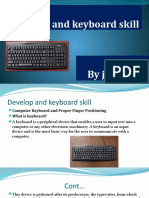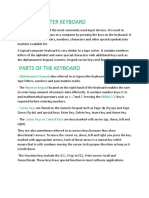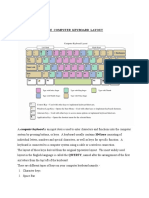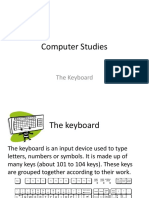0% found this document useful (0 votes)
7 views1 pageKeyboard Notes
The document categorizes keyboard keys into several types, including typing keys for letters and numbers, control keys for actions, function keys for specific tasks, and navigation keys for document movement. It also describes the numeric keypad, modifier keys that alter functions, indicator lights for status, system command keys, volume controls, media keys for playback, and special keys for unique actions. Each category includes examples to illustrate their functions.
Uploaded by
kaneno karabuCopyright
© © All Rights Reserved
We take content rights seriously. If you suspect this is your content, claim it here.
Available Formats
Download as PDF, TXT or read online on Scribd
0% found this document useful (0 votes)
7 views1 pageKeyboard Notes
The document categorizes keyboard keys into several types, including typing keys for letters and numbers, control keys for actions, function keys for specific tasks, and navigation keys for document movement. It also describes the numeric keypad, modifier keys that alter functions, indicator lights for status, system command keys, volume controls, media keys for playback, and special keys for unique actions. Each category includes examples to illustrate their functions.
Uploaded by
kaneno karabuCopyright
© © All Rights Reserved
We take content rights seriously. If you suspect this is your content, claim it here.
Available Formats
Download as PDF, TXT or read online on Scribd
/ 1






























































